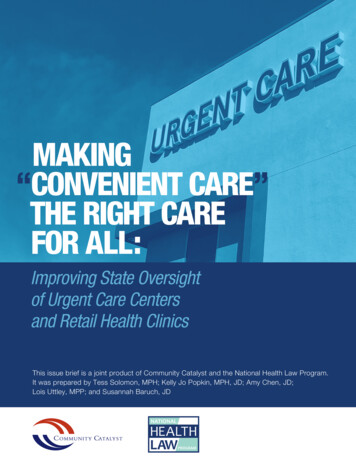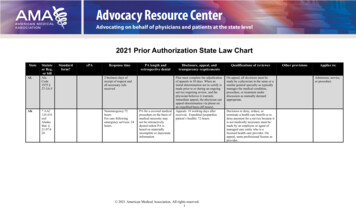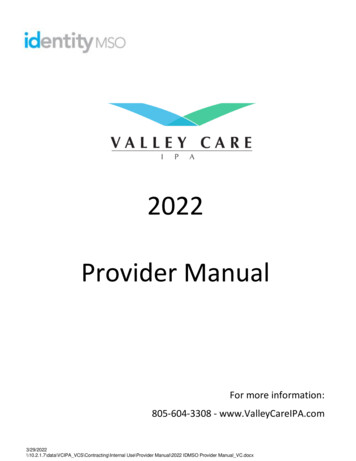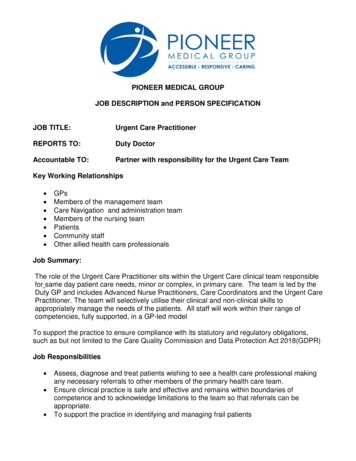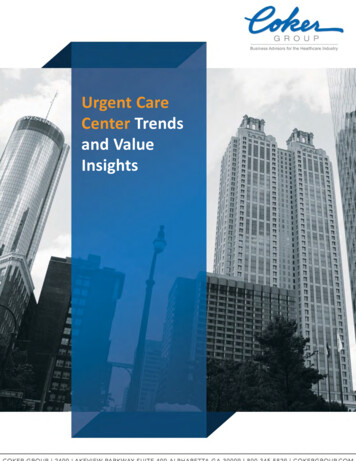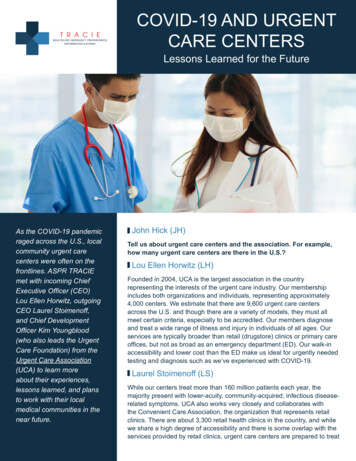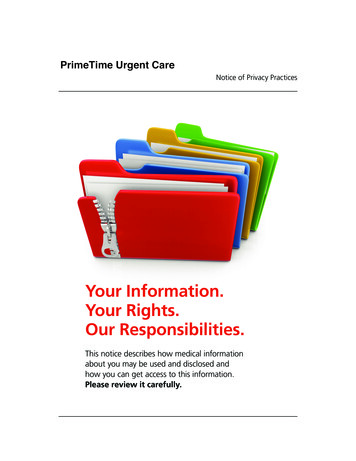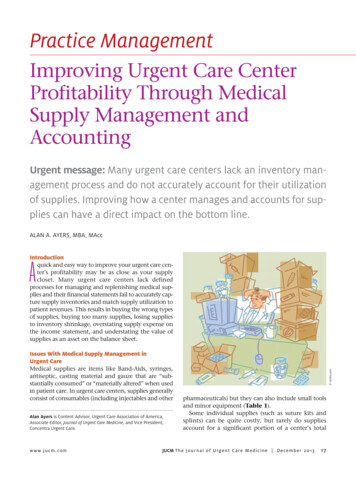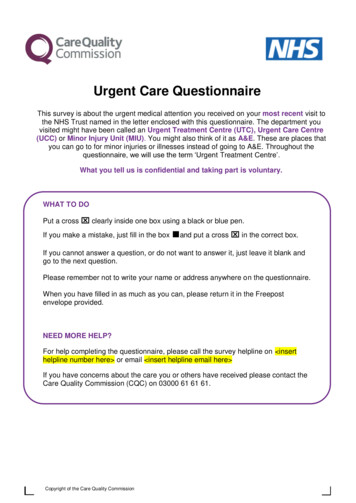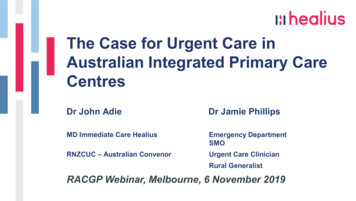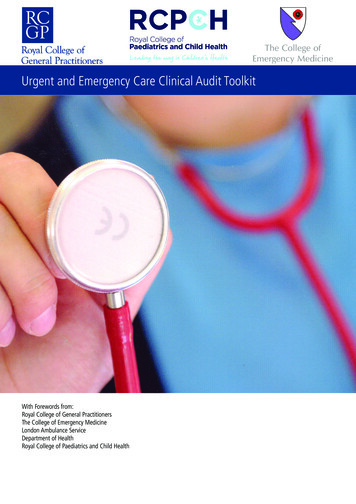
Transcription
Urgent and Emergency Care Clinical Audit ToolkitWith Forewords from:Royal College of General PractitionersThe College of Emergency MedicineLondon Ambulance ServiceDepartment of HealthRoyal College of Paediatrics and Child Health
PageiiII
Urgent and Emergency Care Audit Toolkit Reference Group MembersDr Agnelo FernandesProf. Jonathan BengerDr Simon AbramsStephen AndersonDr Tina SajjanharDr Fenella WrigleyDr Simon StockleyLayla BrokenbrowAnthony ChuterDr Peter FoxJanet HaslamDr Fiona JewkesTom MecrowDr Imran RafiDr Douglas RussellDominic ConlinClare SandlingMike WalkerChair Urgent and Emergency Care Audit Toolkit Reference GroupCollege of Emergency MedicineUrgent Care 24Department of HealthRoyal College of Paediatrics and Child HealthLondon Ambulance ServiceFaculty of Immediate Care (RCS Edin)Clinical Innovation and Research Centre, RCGPRCGP Patient Partnership GroupNHS PathwaysNHS DirectNHS PathwaysClinical Innovation and Research Centre, RCGPClinical Innovation and Research Centre, RCGPTower Hamlets PCTNHS SW LondonDepartment of HealthRCGP Patient Partnership GroupEvaluation Team, Clinical Innovation and Research Centre (CIRC) RCGPSophia WorochModupe OkuboteRichard WebbIsabella KirchnerHead of Clinical Innovation and ResearchInterim Programme ManagerDesign and FormattingInterim Project SupportTom MecrowLayla BrokenbrowProject Officer (1st Stage)Programme Manager: Clinical Innovation Work Stream (1St Stage)PageiiiI
ivPage II
ft Audit Toolkit6The Toolkit Defined–Context and Application8References22Appendices243Page 1
AcknowledgementsWe are grateful to the following people and their respectiveorganisations for piloting the toolkit and giving their feedbackLead AuditorOrganisationDr LinneyCroydoc (Out of Hours GP)Dr KelvinSelsdon Park Medical PracticeDr StockleyAssura Stockton Redcar & Tithebarn Walk–In CentresDr GrahamFairview Medical CentreDr HayhurstAddenbrookes Hospital Emergency DepartmentMs MellardNHS DirectDr GavinSalford Royal Hospitals NHS Foundation TrustProfessor BengerUniversity Hospitals Bristol NHS Foundation Trust (ED)Mrs JeffriesBARDOC (Out of Hours GP)Dr MohammedBARDOC (Out of Hours GP)Mrs LeeNHS Central Lancashire Primary Care Trust;Skelmersdale Walk–In CentreDr KrishnanMalling Health SandwellMrs GandhiBrigstock Medical PracticeDr RoopWrexham Maelor HospitalDr JohnsonCentral Notts Clinical ServicesSister WattsUckfield Hospital Minor Injury UnitDr SajjanharUniversity Hospital LewishamDr NayeemUniversity Hospital LewishamDr HickmanSomerset Accident Voluntary Emergency ServicesDr Leach BASICS WorcestershireMiss DuckettNorth East Ambulance Service (NHS Pathways)Ms FoodyNorth East Ambulance Service (NHS Pathways)Dr WrigleyLondon Ambulance ServiceDr ChowdhuryParchmore Medical CentrePage 2
ForewordsOut of hours care is usually accessed at a time when patients can be at their most frightened and vulnerable.There are of course many excellent examples of services but patients can find it difficult and complicated tonavigate the system.Therefore the Royal College of General Practitioners (RCGP), in partnership with The College of EmergencyMedicine (CEM), has developed this Urgent and Emergency Care Clinical Audit Toolkit, which we hope will be ofuse to all commissioners and providers.This toolkit has also been extensively piloted by the RCGP and CEM and is also endorsed by the AmbulanceService and the Royal College of Paediatrics and Child Health.Our patients have a basic right to a high quality of urgent care at whatever time they use the health service andwe have the knowledge and ability to provide robust system checks to help deliver and ensure good, safe practiceis learnt from and maintained.This toolkit has been produced and piloted with funding from the Department of Health. I would like toacknowledge the excellent work of Dr Agnelo Fernandes, RCGP Clinical Champion for Urgent Care, and ProfessorSteve Field, immediate past chair of the RCGP, for all their hard work and sterling efforts in driving this projectforward. We would like to see it adopted by all urgent care providers to ensure a seamless, safe and effectivejourney for all patients wherever urgent care is provided.Dr Clare Gerada, RCGP Chair of CouncilThe College of Emergency Medicine welcomes this important initiative. The recognition that urgent and emergencycare comprises a continuum of practice will drive better, more consistent models of care. The current fragmentedsystem inevitably leads to confusion and uncertainty amongst the public. There are important inefficiencies inboth clinical and cost arenas. The risk and safety agenda are inadequately addressed.Quality assurance and continuous improvement are fundamental requirements of any healthcare system. Thisrobust and tested toolkit will provide those involved in commissioning and providing urgent and emergency care24/7 with an invaluable addition to evaluate current practice and deliver better care for our patients.Mr John Heyworth, President College of Emergency MedicineThe ambulance service welcomes the development of this urgent and emergency care clinical audit toolkit. Itrecognises that ambulance services are a key part of urgent and emergency care provision and helps to not onlycompare the standard of care provided across providers but also gives us an opportunity to begin to audit face toface care as well as telephone assessments. The toolkit really does help us focus on the quality of care we provide.Peter Bradley, National Ambulance Director DH & LAS Chief ExecutivePage 3
As an emergency medicine consultant my job is to provide the best care for my patients, so that they recoverquickly. To help me achieve this I need some evidence of the quality of the care I deliver and of that given in mydepartment.Clinical audit, with timely feedback to all staff, is one of the most powerful tools available to assess, and thereforeto drive improvements in, the quality, safety, consistency and value for money of urgent and emergency care. Itcan also be of enormous benefit to individual clinicians and, carried out correctly, can provide real motivation toall of us to improve the quality of the care we deliver. Undertaken routinely, clinical audit can contribute to theculture of continuous improvement we need to adopt in the NHS.The NHS is undertaking various initiatives to improve clinical outcomes and service experience. Nationally newindicators have been announced in A&E and ambulance services and over the next year will be developed for othercomponents of urgent and emergency care. These will work with the new NHS Outcomes Framework and NICEquality standards to encourage and demonstrate improvements. Locally organisations will be demonstrating thequality of their care. Clinicians will also need to demonstrate the quality of their care for their regulatory bodies.This toolkit has been developed to support clinical audit across the range of urgent and emergency care settingsfrom out–of–hours GP services to ambulance services to emergency departments. As such, it is well–placedto support greater consistency and reliability of care across these different settings. Greater consistency andreliability of care is required if we are to deliver more efficient urgent and emergency care that also deliverscontinuously improving quality and a better experience for patients.I hope that many organisations will utilise this toolkit as an important component of the work to continuouslyimprove their clinical care.Professor Matthew W Cooke, National Clinical Director Urgent and Emergency Care, Dept of HealthRegular and well conducted clinical audit helps clinicians improve services. Provided we close the audit loopby introducing changes, where required, and then undertaking a re–audit, the care of patients is improved.Undertaking audit in urgent and emergency care is particularly challenging given the number of organisationspotentially involved and the short time each patient is in contact with each service. The Royal College ofPaediatrics and Child Health has experience recently of undertaking a study of how parents with a febrile childtry to navigate through the various options for urgent and emergency care and this certainly reinforced the factthat the public find advice confusing and sometimes contradictory. Providing a ready made audit toolkit to helpclinicians undertake clinical audit in urgent and emergency care will be very helpful particularly as the NationalHealth Service is envisaged as having an increasing number of competing providers. We know that a qualityservice is one which is safe, effective and as good an experience as possible for the patient and their carers, andaudit can address all three elements of a good quality service.Professor Terence Stephenson President, Royal College of Paediatrics and Child HealthPage 4
IntroductionThis report comprises the evaluation of a six month projectundertaken by the Royal College of General Practitioners (RCGP)and The College of Emergency Medicine (CEM). RCGP and CEMhave worked closely with a wide range of Urgent Care providersand representatives throughout the course of the project.tool, mapping variation and consistency to the point whereconsensus was reached on a ‘universally’ acceptable audit tool.A guidelines framework completed the toolkit.Following the final drafting of the toolkit by the reference group,the toolkit was piloted in April 2010.The overarching aim of the project has been to work towardsthe creation of a universal clinical audit toolkit, applicable acrossa wide range of urgent and emergency care situations, andone which supports the implementation of a system of routineclinical audit along all urgent care pathways. Current urgent careprovision pathways are often fragmented and complex, resultingin confusing care journeys for the many patients experiencingthem. This situation is further complicated by the increasingplethora of organisations offering urgent care, and the widerange of professionals involved in the provision of that care.Specifically, the toolkit aims to provide: Practical guidance on the implementation of clinical audit inurgent and emergency care provider service settings. A framework for assessing the quality of individual provider–patient interactions, to include written records and/or audio/video recordings, conducted as either telephone or face–to–face consultations. Exemplars that demonstrate how clinical audit contributesto the overarching clinical governance and educationalagendas, thereby improving patient safety and the quality ofthe care.The evaluation details the development and piloting of the audittoolkit conducted across a range of different urgent care settings,to include:Walk–in Centres, NHS Direct, Ambulance Service, Out of HoursDoctors, Urgent Care Centres, GP Medical Practices and HospitalEmergency Departments.Draft Toolkit DesignThe Project Reference Group met on ten separate occasionsand during this time developed and refined the Urgent CareAudit Toolkit, a final draft of which was produced at the endof April 2010. The toolkit comprised, in part, the amalgamationof several existing audit tools, drawing on those aspects foundto be most consistently applicable and relevant to practice. Thisprocess involved incrementally building audit tool upon auditPage 5
Draft Audit ToolkitThe draft toolkit was piloted over an eight week period,commencing April 2010. The original plan had been to conductthe pilot over a three week period; however this provedimpracticable for a number of reasons. Urgent and EmergencyCare sites throughout the country were busy conducting auditsand surveys during this period, particularly the National PatientSatisfaction Survey. This put significant limitations on the abilityof sites to commit resources to undertaking the pilot within sucha short time frame.Type of Urgent Care ProviderNumber of SitesOut of Hours Doctor2Emergency Department6Walk–In Centre4Medical Practice5BASICS (Pre–HospitalDoctors)EmergencyCare2NHS Pathways1NHS Direct1Ambulance Service1The aim of the pilot was to evaluate the ‘usability’ of the audittool, and the ‘usefulness’ of the toolkit. We were particularlyinterested to elicit views on clarity, relevance and ease of use ofthe audit in the urgent care environment being audited.Table 1: Types of Urgent Care ProvidersWe did not set out to test the effectiveness of the tool in practice.This would have required measuring the reported increase ordecrease in the quality of consultations of repeated audits in thesame clinical settings.Urgent Care Audit Toolkit drafts were distributed to all pilot sitesand sites were linked up to RCGP by teleconference to facilitateinter–site and Reference Group representation discussions andstandardisation of procedures.Audit criteria were developed from current best practiceguidelines within the different Urgent and Emergency Careservices. Their content is not being evaluated. However theapplicability of each criterion to all the Urgent and EmergencyCare services within a generic tool was evaluated as part of thepilot.Following the teleconference, the pilot sites agreed to completefifty audits using the audit tool, over a period of eight weeks.Pilot Site SelectionPilot sites were proposed and recruited by members of theToolkit Reference Group, and through advertisements in nationalurgent care bulletins. Collaborating sites signed a Service LevelAgreement with RCGP to promote consistency across andwithin different sites and clinical specialities. The initial selectionof thirty pilot sites was revised down to twenty two sites as aresult of sites not being able to commit to the duration of theproject due to other workload responsibilities. The twenty twosites involved in piloting the audit toolkit represented a range ofeight different urgent care settings (see Table 1–Types of UrgentCare Providers).Pilot Site Data Collection MethodsPilot sites were asked to evaluate the audit toolkit using a selfcompletion questionnaire. These were completed by the auditorand comprised a series of open ended and closed questions togather both quantitative and qualitative data. The questionnairewas designed to collect information from pilot site auditors onsix key themes. All but one of these themes related directly to theaudit in terms of its structure, composition, content, applicabilityand user friendliness. Information was also sought from auditorson the length of time taken to complete individual audits andwhether they would recommend the use of the audit toolkit fortheir clinical area.Due to the inherent differences in audit methods betweenand across services, the pilot sites were given flexibility in howthey undertook the audit. Sites were given freedom in termsof choosing the structure of their audit team, which inevitablyimpacted on the evaluation as the evaluation team had nocontrol over individual team skill sets and competences. It wastherefore important to factor analyse the data to take intoaccount the type of audit they conducted i.e. retrospective fromclinical notes, retrospective from audio recordings.All but one evaluation form was returned to the RCGPelectronically. Once stored, local identifying data were codedPage 6
and anonymised. The quality, breadth and nature of the in–depth open–ended data rendered the need for separate focusgroups unnecessary.Data AnalysisData were analysed using SPSS software to cross–tabulate dataacross and within pilot sites. Qualitative data were analysedusing comparative analysis techniques.In addition to the data collected during the pilot, secondarydata on the pilot sites were collected from various public bodies,including the 2009 Care Quality Commission data.Audit DataSeventeen of the sites conducted retrospective clinical notesaudits. The Out of Hours doctors, NHS Pathways, and NHS Direct,used a combination of notes and retrospective audio recordingto conduct the audit.Sites were asked to record the length of time taken to completeeach audit. 72% of the pilot sites took less than 15 minutes toconduct one audit, and no sites took more than 20 minutes.50% of sites that undertook the audit using retrospective clinicalnotes–thought the audit took too long to complete. It was notedby the Ambulance Service that the tool was ‘very quick to fill’if the consultation was straightforward; however the lengthof time to complete the audit increased where any extra notetaking became necessary.Audit Team CompositionAs this was only a pilot study most sites were unable to provide afull ‘audit team’ as recommended in the toolkit. The exceptionsto this were the two Out of Hours and NHS Direct sites, whichroutinely audit individual clinicians and were able to use theiraudit teams already in place. In all other providers the auditwas conducted by an individual, usually a lead doctor or regularaudit lead. The variation in team composition should be takeninto account when reading the findings of the pilot study.Page 7
The Toolkit Defined–Context and ApplicationIn the summer of 2010, the coalition government publisheda white paper “Equity and Excellence: Liberating the NHS”1,which sets out the Government’s strategy for the NHS, with theintention to create an NHS which is more responsive to patients,achieves better health outcomes, with increased autonomy andclear accountability at each level.The White Paper ‘Equity and Excellence” 1 includes a commitmentto develop a coherent 24/7 urgent care service, incorporatingGP out–of–hours services, in every area of England. This willbe supported (subject to pilot evaluation) by a single telephonenumber–111–helping patients access all urgent care services.The aim behind this is to make it easier for patients to get theright care, in the right place, at the right time.On 17 December, the Secretary of State announced theintroduction of two sets of clinical quality indicators from April20112. One, for A&E services, replaces the four hour waitingtime standard. The other, for ambulance services, replaces theCategory B, 19 minute response time target. The purpose ofthe clinical quality indicators is to provide a more balancedand comprehensive view of the quality of care. This includesoutcomes, clinical effectiveness, safety and service experience,as well as timeliness. The clinical quality indicators also aim tostimulate a more sophisticated discussion and debate aboutquality of care to support a culture of continuous improvement.At the same time the Quality, Innovation, Productivity, Prevention(QIPP) initiative is being applied at national, regional and locallevels to support clinical teams and NHS organisations toimprove the quality of care they deliver while making efficiencysavings that can be reinvested in the service to deliver year onyear quality improvements. QIPP is engaging large numbersof NHS staff to lead and support change. At a regional andlocal level there are QIPP plans which address the quality andproductivity challenge, and these are supported by the nationalQIPP workstreams which are producing tools and programmesto help local change leaders in successful implementation.In the light of these developments, making an effectiveuniversal clinical care audit tool available is important becauseit constitutes the single most important method, which anyhealthcare service provider can use to understand the quality ofthe service that is being provided. It is also a powerful mechanismfor ongoing quality improvement, identifying weaknesses ordelivering clinical and cost effectiveness. It is anticipated thatthis Universal Urgent and Emergency Clinical Audit Toolkit willhelp in measuring both within and across urgent and emergencyPage 8care service providers, the quality of patient care and enco
Doctors, Urgent Care Centres, GP Medical Practices and Hospital Emergency Departments. Draft Toolkit Design The Project Reference Group met on ten separate occasions and during this time developed and refined the Urgent Care Audit Toolkit, a final draft of which was produced at the end of April 2010. The toolkit comprised, in part, the amalgamation
